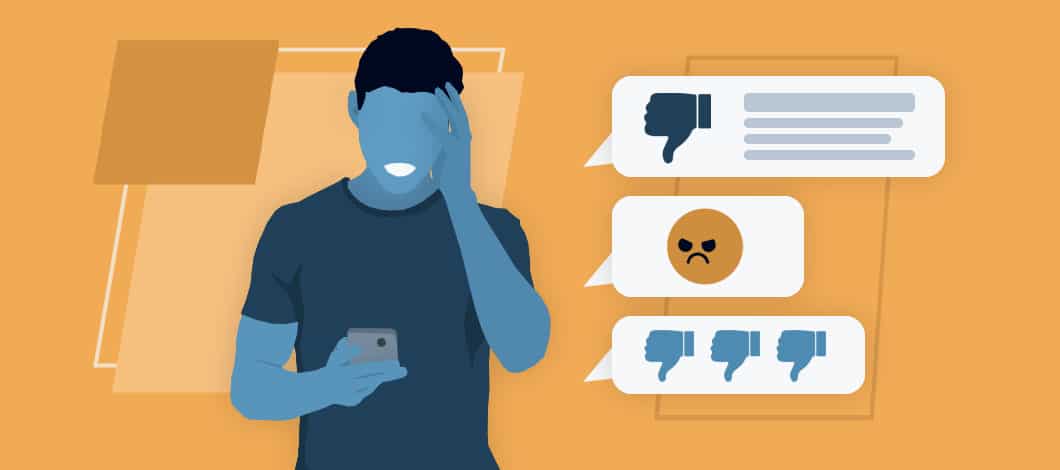Cyberbullying and online harassment can happen to anyone, including employees or your company. Understanding social media harassment helps prevent it.
Explore the effects of social media aggression, learn how to deal with harassment and use our 6 tips to prevent it.
What Is Social Media Harassment?
Social media cyber harassment refers to stalking, threatening physical violence, name-calling and purposeful embarrassment on a social media platform.
According to the Pew Research Center, “75% of targets of online abuse — equaling 31% of Americans overall — say their most recent experience was on social media.”
Cyberbullies may target brands using methods also used to target individuals. In these cases, antagonists may stalk or threaten companies with or without a social media presence.
Social media bullying can turn into email harassment or physical threats at your workplace.
Examples of Social Media Bullying
Online intimidation and threats come in all formats. Some bad actors with too much time on their hands attack individuals and brands for no reason.
Others have a private agenda, perhaps a beef with the business or individual, and choose to pursue them online.
They may show up on every Facebook advertisement or Twitter post to leave a negative statement. Or create a lookalike account to publicly embarrass a company or chief executive or ruin a brand’s reputation.
On the other hand, certain public relations (PR) nightmares could result in a doxing event, where someone publishes personal contact information about your company, employees or customers on social media.
Likewise, your company could start receiving terrible Facebook reviews, tainting an otherwise stellar record. Current and former co-workers or third-party vendors could try to humiliate a brand or individual publicly or create a campaign to get someone fired.
Social Media Harassment Laws
There aren’t any specific social media harassment laws. However, various statutes cover actions that take place on social channels.
Stalking is a federal crime, and 18 U.S. Code Section 2261A imposes penalties for anyone using “the mail, any interactive computer service or electronic communication service or electronic communication system of interstate commerce, or any other facility of interstate or foreign commerce” with the intent to injure, intimidate, kill, harass or surveil someone.
If cyberbullying is considered discriminatory, it could fall under various antidiscriminatory laws. Other rules could apply to social media defamation or criminal threats.

Cyber Bullying: Impact on Small Businesses
Cyber harassment on social media affects individuals in your organization, your company reputation and your personal brand.
If cybercriminals also are your employees, and they’re doing it during business hours, it could put your company in the middle of a lawsuit or potential criminal charges.
Employees that harass co-workers may violate workplace rules and create a hostile environment. External antagonizers may go after employees or management on social media, leading to people quitting their jobs.
Consequently, the negative publicity and internal strife could cause reputational harm. Customers, vendors and potential employees could lose trust in your company and not want to do business with you.
Cyberbullying also affects your sales. Most small businesses market their products and services on social media and rely on social media reviews. Quitting social media is rarely an option.
6 Social Media Harassment Prevention Tips
Dealing with cyberbullying can be time-consuming and frustrating. Prevention is far better than waiting until a problem occurs.
But when it does happen, it’s essential to know how to stop online harassment. Use these tips to prevent and halt cyberbullying:
1. Create and Enforce Social Media Cyberbullying Policies
Your internal policies are one of your best defenses against cyber harassment.
Have a lawyer look over your workplace harassment policies. If they don’t include electronic devices or remote workplaces, it’s time to update them.
Identify actions that qualify as harassment and make penalties clear.
Improve security by combining rigorous and repetitive training with good password and security policies.
These steps, along with guidelines for accessing social media on company time or devices, can reduce risks to your business.
2. Increase Employee Awareness
Many states require annual training on topics such as sexual harassment, including texting or instant messaging sexual messages or photos to an unwilling party.
Likewise, hiring managers may undergo educational classes for antidiscrimination laws.
Whether training remotely or in person, trainers should discuss the social media element and relate it to actions or activities in individual job roles.
All training programs should reinforce your social media and cyber harassment policies, including how to report online harassment and what evidence to preserve. They also should address the social and emotional factors that lead to someone stalking or harassing online and explore how victims feel.
Listen and respond to employee concerns in ways that reflect your corporate culture and dedication to workplace safety.
3. Deploy Social Listening Tools
A targeted attack against your brand could start small or happen at all once. Social listening tools can alert you when your brand or brand-related keywords and hashtags appear on social media.
This information helps you be proactive and get ahead of any possible PR disaster or harassment tactic.
4. Pick Your Battles
Any business dealing with customers is subject to some amount of questionable behavior, especially when you aren’t meeting face-to-face. However, in-person confrontations have certainly increased in recent years.
You have to decide where the line is for you and your employees.
In addition, your response can potentially increase the number of threats. If you’re attacked, avoid the instinct to fight back verbally.
Instead, approach it as you would any other call that comes into customer service. Apologize for their poor experience, don’t engage in negative behaviors and escalate the issue if it continues.
5. Understand How to Report Online Harassment
Being harassed on social media can make people feel ashamed or embarrassed. They may not immediately report it because they fear losing their job or facing retaliation or unconscious bias.
It’s imperative to address these concerns regularly and keep various lines of communication open so that employees can use their preferred channel.
Ask your employees if they know what to do if someone is cyber harassing you and encourage them to speak out.
Everyone on your team should know when to report to:
- Supervisors: Give employees specific instructions for when and how to report social media harassment to their managers.
- Business owners: Staff may try to handle minor issues themselves. Provide guidelines for when to escalate the matter and inform executives.
- Social media platforms: File a report for any activities that violate the social channels’ terms of the agreement. Follow-up through customer service if you don’t receive a response.
- Authorities: Report online threats to your safety or property to your local police. Doing so starts a paper trail, and if it continues or escalates, you’ll have a documented history.
6. Block Bullies and Go on the Defensive
If your brand or individuals experience cyberbullying, that goes beyond the venting of an upset customer or former employee, immediately block the account on the social media channel.
Next, report the user on the social media platform and inform other affected parties.
Go on the defensive by closely monitoring your accounts and watching for brand lookalike pages that aim to mimic and damage your company.
As with any incident, staying ahead of the cybercriminal and getting your version of the story out first is better for public relations than waiting for something worse to occur.
Be Proactive to Recognize and Address Online Harassment
Antisocial and aggressive interactions have increased in real life and on social media. Combat it by ensuring your team understands cyberbullying, when to report it and how to respond.











